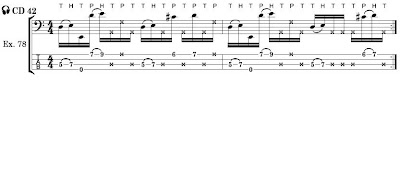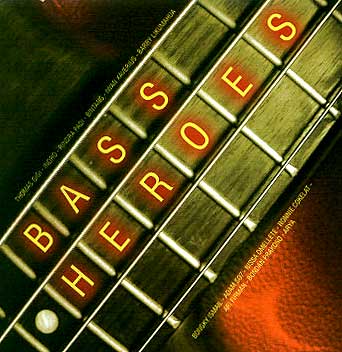Funk Fingers are a kind of drumsticks that are attached to the fingers of a bass player for producing extra-funky sounds on a bass guitar. They were created by Tony Levin (Peter Gabriel, King Crimson, Liquid Tension Experiment) and his guitar tech, Andy Moore. The aim was to recreate the effect of drumming on the strings of one’s bass as done by drummer Jerry Marotta for Peter Gabriel’s song “Big Time” when recording the album So.
The original Funk Fingers were strapped to the fingers, but after some experimentation with cutouts and elastic loops for fingers, Levin decided the most comfortable design has a rubber cap at the end of the fingers. The current version of Funk Fingers comes with two different lengths for his index and middle finger.
E A D G STANDER TUNING
S= SLAP P=POP
G-----------------------------8-7--5----------
D---5----6--------10-8-10-8------------5------
A---------------------------------------------
E------3----4------------------------------3--
P S P S P P P P P P P P S
G-------------------------------
D------6----------------------
A-----------PLAY 4 TIMES
E--------4------------------
S P
PLAY 4 TIMES
G-----------------------------------3-4-------
D-----------------5--7-5-1-2-3---2-------5-4-2
A-----------5-7------------------------------
E--3-3-4-5--------------------------------------
S S S S P P P P P P P P
G---------------
D---------------
A----5----------
E--3-----7-5---3
S P S S S
G-------7--8--9
D--------------
A---------------PLAY 2 TIMES
E-0-0------------
S S P P P
G-----------------
D--------9------9-9
A-------------------
E--7-7------7-7-------
S S P S S P P

Funk music was very popular during the bwertahun-year. This song is a great appreciation for this genre. As I wrote in my mind it has a Funk Music and its variations, I created a mix with other styles and modern ideas. The cocktail music records generated from this mixture is refreshing and sweet, with natural scenery that comes to mind and the beautiful scenery.
Like African-inspired music a lot, Funk usually consists of a complex groove with rhythm instruments like electric guitars, electric bass, Hammond organ, and drum rhythms played each other. Funk band sometimes has a horn section of several saxophones, trumpets, and in some cases, the trombone, which plays rhythmic "hits".
Funk is an American music genre that originated from the late 1960s when African American musicians blended soul music, soul jazz and R & B into the form, danceable rhythms of new music. While Funk de-emphasizes melody and harmony, and brings a strong rhythmic groove electric bass and drums to the foreground, if you want to create a unique blend with modern ideas however you must re-introduce the melody, and melody of the flute is the perfect way to do it, considering how This instrument has been considered a great player in the 70s. This is example band's of flow music "Funk" Breakesta, Red Hot Chili Pepper n the others.
Soul Music
The 1950s recordings of Sam Cooke, Ray Charles and James Brown are commonly considered the beginnings of soul music. Solomon Burke's early recordings for Atlantic Records codified the style, and as Peter Guralnick writes, "it was only with the coming together of Burke and Atlantic Records that you could see anything resembling a movement." Burke's recordings, in the early 1960s, of "Cry to Me," "Just Out of Reach" and "Down in the Valley" are considered classics of the genre.
In Memphis, Stax Records produced recordings by Otis Redding, Wilson Pickett and Don Covay (Covay also recorded in New York City for Atlantic). Joe Tex's 1965 "The Love You Save" is another classic soul recording. An important center of soul-music recording was Florence, Alabama, where the Fame Studios operated. Jimmy Hughes, Percy Sledge and Arthur Alexander recorded at Fame; later in the 1960s, Aretha Franklin would also record in the area. Fame Studios, often referred to as "Muscle Shoals", after a town neighboring Florence, enjoyed a close relationship with Stax, and many of the musicians and producers who worked in Memphis also contributed to recordings done in Alabama.
Another important Memphis label that produced soul recordings was Goldwax Records, whose owner was Quinton Claunch. Goldwax signed O. V. Wright and James Carr, who would go on to make several records considered essential examples of the genre. Carr's "The Dark End of the Street," written by Chips Moman and Dan Penn (often incorrectly credited to Dan Penn/Spooner Oldham), was recorded at two other important Memphis studios, Royal Recording and American Sound Studios, in 1967. In addition, American Studios owner Chips Moman produced "Dark End of the Street," and the musicians on the record were his house band of Reggie Young, Bobby Woods, Tommy Cogbill and Gene Chrisman. And Carr also made recordings at Fame, utilizing musicians David Hood, Jimmy Johnson and Roger Hawkins.
Aretha Franklin's 1967 recordings, such as "I Never Loved a Man That Way I Love You," "Respect" (a song written by Otis Redding), and "Do Right Woman-Do Right Man," are commonly considered to be the apogee of the soul-music genre, and among its most commercially successful productions. During this period, Stax artists such as Eddie Floyd and Johnnie Taylor also made significant contributions to soul music. By 1968, the soul-music movement had begun to splinter, as James Brown and Sly and the Family Stone began to expand upon and abstract both soul and rhythm and blues into other forms. As Guralnick writes, "More than anything else, though, what seems to me to have brought the era of soul to a grinding, unsettling halt was the death of Martin Luther King in April of 1968."
Howard Tate's recordings, in the late 1960s, for Verve Records, and later, for Atlantic, produced by Jerry Ragovoy, are another important body of work in the soul genre.
Later examples of soul music include the recordings of The Staple Singers, such as "I'll Take You There," as well as the 1970s recordings, done at Willie Mitchell's Royal Recording in Memphis, of Al Green. Mitchell's Hi Records continued the tradition of Stax in that decade, releasing not only many hits by Green but also important contributions from Ann Peebles, Otis Clay, O. V. Wright and Syl Johnson. Bobby Womack, who recorded with Chips Moman in the late 1960s, continued to produce soul-music recordings in the 1970s and 1980s.
Detroit was another city which produced some important late-soul recordings; producer Don Davis, from the city, worked with Stax artists such as Johnnie Taylor and The Dramatics. The Detroit Emeralds, on early-'70s recordings such as "Do Me Right," are an important link between soul and the later disco style. Motown Records artists such as Marvin Gaye and Smokey Robinson contributed to the evolution of soul music, although their recordings were conceived in a more overtly pop music vein that those of Redding, Franklin or Carr.
Although they are somewhat different from classic soul stylistically, recordings by Chicago-based artists such as Jerry Butler and The Chi-Lites are often considered part of the genre.
Music produced by white musicians which is stylistically similar to black soul music sometimes is called blue-eyed soul.
By the early 1970s, soul music had been influenced by psychedelic rock and other influences. The social and political ferment of the times inspired artists like Gaye (What's Going On) and Curtis Mayfield (Superfly) to release album-length statements with hard-hitting social commentary. Artists like James Brown led soul towards more dance-oriented music, resulting in funk music; funk was typified by 1970s bands like Parliament-Funkadelic, The Meters, and James Brown himself, while more versatile groups like War, the Commodores and Earth, Wind and Fire also became popular. During the 70s, some highly slick and commercial blue-eyed soul acts like Philadelphia's Hall & Oates achieved mainstream success, as well as a new generation of street-corner harmony or "city-soul" groups like The Delfonics and Howard University's Unifics.
By the end of the 70s, disco was dominating the charts and funk. Philly soul and most other genres were dominated by disco-inflected tracks. During this period, groups like The O'Jays and The Spinners continued to turn out hits.
After the death of disco in 1980, soul music survived for a short time before going through yet another metamorphisis. With the introduction of influences from electro music and funk, soul music became less raw and more slickly produced, resulting in a genre of music that was once again called R&B (although the term is no longer an acronym), usually disinguished from the earlier rhythm and blues by identifying it as "contemporary R&B".





